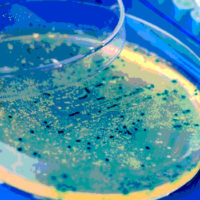New Testing Application Advances Glyphosate Detection in Food Products

In the minds of many, the symbiosis between food and pesticides is unbreakable. Globally, pesticides—herbicides, insecticides, fungicides, and rodenticides—are used to protect food and humans from various diseases and feed a burgeoning world populace estimated to reach 8 billion by 2023. At the same time, serious environmental and human health concerns (e.g., cancer, kidney damage, and nervous system disorders) associated with these substances have caused legions of health-minded consumers to approach food shopping with tremors of trepidation.
Due to their persistence in the environment, pesticide residues are commonly found in a wide range of foods and beverages—ranging from water and wine to fruits and vegetables—at levels that are considered safe by a host of national and international bodies. In studies, residues have also been detected in human breast milk samples, prompting concerns about prenatal exposure and health effects in children.[1]
Historical Context
From a historical lens, pesticides are seemingly never too far from intense public discourse and controversy.
In the early 1970s, dichlorodiphenyltrichloroethane (DDT), the first synthetic pesticide, was banned in the U.S. by the Environmental Protection Agency (EPA). DDT was introduced during World War II and was highly effective in combatting malaria, typhus, and other insect-borne human diseases among military and civilian populations. Its success was so great that Paul Müller, a Swiss chemist who discovered DDT's insecticidal action, was awarded the prestigious Nobel Prize in 1948.[2]
EPA’s decision to ban DDT was based on mounting evidence of the pesticide's declining benefits, as well as its damaging environmental and toxicological effects.[3] The 1962 landmark book, Silent Spring, by Rachel Carson, a writer and ecologist, kindled public concern over the dangers of DDT, most notably in wildlife, and initiated calls for increased regulatory controls.
Over time, EPA has banned or severely restricted the use of a number of infamous pesticides, such as carbofuran, methomyl, and methyl parathion, on a wide variety of products. Though rare, the agency has withdrawn these designations for some chemicals.
Gauging Glyphosate
Glyphosate, an active ingredient in Roundup™ herbicides and the herbicide used in “Roundup Ready” genetically modified organisms (GMOs), was at the center of a media storm last year. In a sampling program conducted by a consumer advocacy group, high levels of glyphosate were detected in cereal, granola bars, and oatmeal.[4]
News of the results triggered industry, regulatory, and public anxiety due to the extensive use of glyphosate on many crops, including corn, soy, wheat, and oats. Glyphosate, according to a 2016 study, is the world’s most widely used pesticide.[5] The report revealed that:
- 1.8 million tons of glyphosate have been applied in the U.S. since its introduction in 1974
- 9.4 million tons of the chemical has been sprayed on fields worldwide—enough to spray nearly half a pound of Roundup on every cultivated acre of land in the world
- Glyphosate use has risen almost 15-fold worldwide since Roundup Ready GMO crops were introduced in 1996
Results from another research study released the following year found that the exposure of Americans to glyphosate had increased roughly 500 percent since Roundup Ready GMO crops were first introduced in the U.S.[5]
Contentious Debate
Across continents, the risks posed by glyphosate to human health have been the epicenter of contentious debate in recent years. In 2015, the International Agency for Research on Cancer (IARC), a division of the World Health Organization, listed glyphosate as a probable human carcinogen.[5] The group determined there was a particular association between glyphosate and non-Hodgkin's lymphoma.
Appropriately, many governmental agencies, including the European Food Safety Authority, the Australian Pesticides and Veterinary Medicine Authority, Health Canada, and EPA, conducted risk assessments on glyphosate. Each organization concluded that it is unlikely for the herbicide to cause cancer in humans when used in accordance with the label directions as required.[5]
A collection of public health and consumer advocacy groups, however, panned the various assessments, characterizing them as tainted due to their reliance on incorrect information and incomplete data.
Based on IARC’s findings, the California Environmental Protection Agency’s Office of Environmental Health Hazard Assessment stated it would add glyphosate to the state’s Proposition 65 list of chemicals known to cause cancer in 2017.[6] A year later, following much legal wrangling, the U.S. District Court for the Eastern District of California ultimately ruled against the listing.[7]
Advancing New Tools and Technologies
Deep-rooted industry concerns over the safety of glyphosate in food have placed an intensified focus on the development of reliable analytical detection tools and technologies.
In response, AFFINISEP, a global provider of ready-to-use, predeveloped methods and solid-phase extraction (SPE) cartridges, SPE disks, custom resins, and products for passive sampling, recently introduced a new application—the AFFINIMIP® SPE Glyphosate.
The proprietary method, which precedes chromatographic testing, has been successfully utilized for the enrichment and cleanup of glyphosate and its metabolites in several food matrices, including cereal, honey, and apple juice, according to Dr. Sami Bayoudh, technical director and chief scientific officer of AFFINISEP.
During the development of the AFFINIMIP SPE Glyphosate, Bayoudh, who headed the research development group, says a precipitous hurdle to clear was coming up with a sorbent that would trap glyphosate and aminomethylphosphonic acid (AMPA)—the main metabolite of glyphosate—with good yield. For various reasons, typical resins, like hydrophilic-lipophilic balance and divinylbenzene, proved to be unacceptable for that consequential action.
Bayoudh, whose doctorate degree is in polymer physical chemistry, explains, “We had to develop a specific, molecularly imprinted polymer that would allow specific binding of glyphosate and AMPA.”
Since its initial rollout, the AFFINIMIP SPE Glyphosate application has consistently met expectations, demonstrating high capacity retention and excellent performances with recoveries around 80–100 percent.
Earlier this year, AFFINISEP USA was established to directly provide products and services to laboratories in North America. Moreover, Wisconsin-based Gilson, a global manufacturer of sample management and purification solutions for the life sciences industry, is partnering with AFFINISEP to distribute the company’s line of sample preparation and extraction products. AFFINISEP is headquartered in Petit-Couronne, FR.
Human Food Chain
From the water we drink to the food we eat, pesticides are an intrinsic part of the human food chain, necessitating greater regulatory oversight and scientific innovation to minimize the harmful effects of these chemical substances. Moving forward, continued advances in analytical testing and detection will play a fundamental and critical role in the pursuit of proactive and sustainable safety solutions.
AFFINISEP provides innovative kits (analytical chemistry, radiochemistry, and diagnostics) to analytical and R&D laboratories, in addition to small laboratories and leading academic institutes, around the world. AFFINISEP's kits focus on topical concerns about the quality and safety of food and agricultural products, and the monitoring of water quality, soil, foods, pharmaceuticals, cosmetics, chemical, and petroleum products. Learn more at AFFINISEP.com.
References
1. www.ncbi.nlm.nih.gov/pmc/articles/PMC4947579/.
2. www.swissinfo.ch/eng/ddt--from-miracle-chemical-to-banned-pollutant/3253684.
3. www.epa.gov/ingredients-used-pesticide-products/ddt-brief-history-and-status.
4. www.theatlantic.com/science/archive/2018/08/glyphosate-breakfast-controversy/567784/.
5. usrtk.org/pesticides/glyphosate-health-concerns/.
6. extension.oregonstate.edu/pests-diseases/pesticides/glyphosate-questions-answers.
7. www.jdsupra.com/legalnews/u-s-district-court-denies-california-50758/.
Looking for a reprint of this article?
From high-res PDFs to custom plaques, order your copy today!




